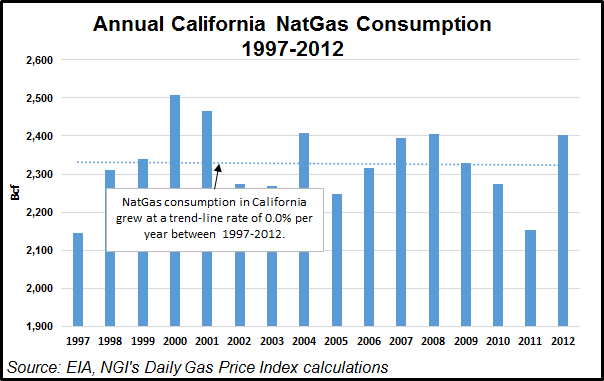Regulatory | NGI All News Access
Three Pipeline Bills Part of California’s Legislative Finale
Three bills to tighten natural gas pipeline regulations — one already awaiting the governor’s signature and the other two awaiting floor votes — have emerged as the California state legislature heads into its final week and mandated adjournment by Aug. 31.

Although they are low profile compared to other energy proposals that have popped up this year, each of the bills was highlighted Thursday in the latest national pipeline safety update by Washington, DC-based law firm Van Ness Feldman LLP.
Each of the bills would alter existing California Public Utilities Commission (CPUC) rules and orders related to intrastate natural transmission pipelines, of which there are many thousands of miles owned and operated by Pacific Gas and Electric, and Sempra Energy utilities Southern California Gas Co. and San Diego Gas and Electric Co.
Awaiting Gov. Jerry Brown’s signature is a bill (AB 1937) to require gas transmission pipeline operators to provide at least three working days notice before starting nonemergency excavations or construction activity within 500 feet of a school or hospital.
AB 1937 passed the lower house Assembly unanimously in May. The Senate added an amendment to require five-year record keeping and other requirements for excavators and operators to use the one-call service to alert other utilities with infrastructure in the area.
A second bill (SB 1389) authored by Sen. Jerry Hill, would eliminate the use of old grandfather clauses in determining the maximum allowable operating pressure (MAOP) for intrastate transmission lines.
Hill’s bill eliminates the ability of operators to use the highest actual operating pressure of a pipeline during a five-year period preceding July 1, 1970 as a means of setting the MAOP. SB 1389 would force operators to determine MAOPs solely on the basis of CPUC rules and orders, which have become more stringent since a September 2010 gas pipeline rupture that killed eight people in San Bruno, CA. The bill is primed to go to the Senate floor.
Finally, the third bill (SB 1371) deals with another hot topic in the context of both safety and climate change efforts in the gas industry and among regulators: methane leak detection. The bill would set new rules and procedures for reducing the amounts of leakage on both transmission and distribution pipelines in the state.
Under SB 1371, the CPUC would be charged with beginning a regulatory proceeding by Jan. 15 to meet four pre-established objectives:
AB 1371 was sent on a 13-4 vote by the Appropriations Committee to the Senate floor with a recommendation for the full body to pass the bill. It is now on third reading preliminary to a vote.
Although natural gas demand in California has been highly volatile since the late 1990s, there has been no long-term consumption growth in the state. Between 1997 and 2012, gas consumption in California has grown at an annualized trend-line rate of exactly 0.0% per year. Annual usage has ranged between a fairly tight 2.15 to 2.51 Tcf during that period, with an annual average of 2.33 Tcf.
© 2024 Natural Gas Intelligence. All rights reserved.
ISSN © 1532-1231 | ISSN © 2577-9877 |
